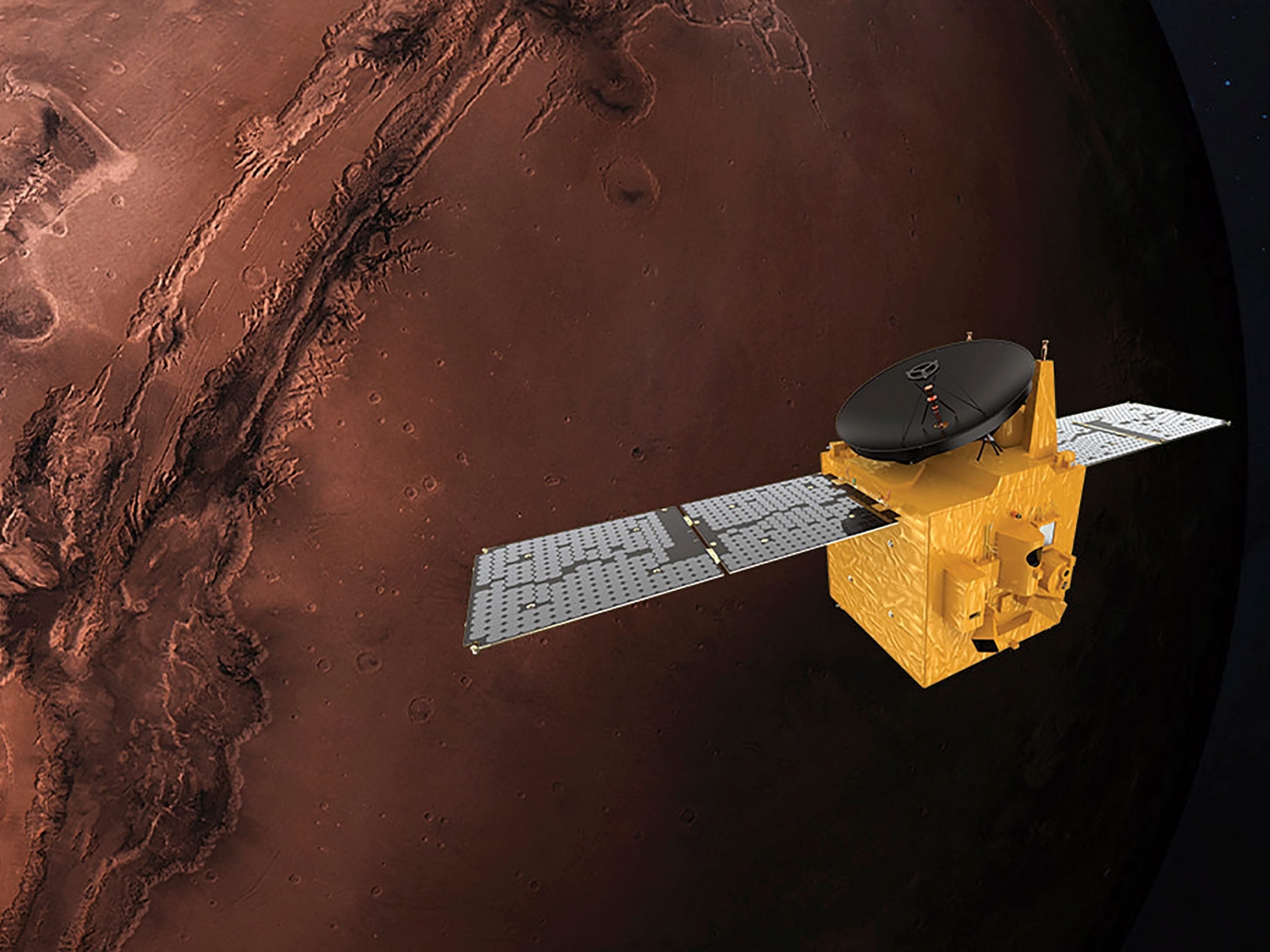
MBRSC via AP
- The United Arab Emirates’ first interplanetary mission, a spacecraft called Hope, reached Mars on Tuesday.
- The orbiter is set to map Mars’ climate across an entire Martian year.
- It’s the first of three Mars missions expected to reach the planet in the next two weeks.
- Visit the Business section of Insider for more stories.
The United Arab Emirates has flown a spacecraft into orbit around Mars, marking a first for the Arab world and a major accomplishment for the country’s young space program.
The Hope probe – “Al-Amal” in Arabic – launched from Tanegashima Island in Japan on July 20, then journeyed seven months to the next planet over.
With Mars in its sights, the SUV-sized spacecraft fired all six of its Delta V thrusters for about 27 minutes on Tuesday, burning through half of its fuel to slow its speed by more than 2,100 mph.
In the days leading up to this braking maneuver, Emirati officials estimated a 50-50 chance of success, according to Agence France-Presse. If the maneuver had failed, the probe could have crashed into Mars or careened past it into deep space.
Instead, the spacecraft fell into an oval-shaped orbit around Mars on Tuesday morning. A signal confirming its success reached mission controllers on Earth at 11:14 a.m. ET.
Hope is the UAE Space Agency's first major mission. It aims to orbit the red planet for a full Martian year (about two Earth years) and create a comprehensive map of the planet's climate.
"It's the very first holistic weather satellite of Mars," Sarah Al Amiri, the mission's science lead, told Space.com.
The probe's unique orbit will allow it to monitor any given region of Mars for hours at a time, watching in infrared, ultraviolet, and visible light as clouds drift by and enormous dust storms roil through the red desert.
The UAE aims for Hope to map weather across the entire planet, through all times of day, over the full Martian year. If successful, this will be humanity's first such picture of the Martian climate.
"It is the time factor that has largely been missing from our knowledge and understanding of the weather system of Mars," Al Amiri said. "During every single time slot of the day, we want to know what happens across an entire day, because weather as we know it is a very dynamic system. We also want to understand what happens in different seasons on Mars. And that requires us to collect data across an entire year."
That data could help scientists better understand Mars' changing seasons and learn how the planet lost the thick atmosphere that protected it 4 billion years ago. Back then, the Martian surface may have been warm enough for liquid water, and scientists think the planet could have supported microbial life.
The UAE is now the fifth country to reach Mars. China is set to follow as the sixth Mars-faring nation on Wednesday, when its Tianwen-1 spacecraft is slated to insert itself into orbit around the planet. (Stay tuned for the Tianwen-1 rover landing in May.)
NASA's new Mars rover, Perseverance, is set to touch down on the planet's surface next week. In terms of visitors from Earth, this is the busiest month in Martian history.
Hope can monitor Martian weather up close and from afar
Sheikh Khalifa bin Zayed Al Nahyan, president of the UAE, announced in 2014 that the country would be going to Mars. The decree came with a deadline - 2021 - to commemorate the nation's 50th anniversary.

Kyodo via Reuters
The Mohammed bin Rashid Space Center was tasked with developing and building the Mars-bound spacecraft. Engineers there equipped the orbiter with three scientific instruments to study Martian weather in infrared light, capture high-resolution photos, and measure atmosphere loss in ultraviolet.
The probe's irregular, or "elliptical," orbit will allow it to capture a unique picture of Martian weather and climate over time.
"When you're very close to Mars, you're moving as fast as Mars is turning on its axis, and therefore, you observe one side of Mars during multiple times of the day. And as you get farther away and you get slower, we observe several time zones on Mars in several locations," Al Amiri told Space.com. "We keep on doing this over the course of an entire 10-day window, and by 10 days, we've fully mapped everywhere on Mars during every time of the day."
As Hope circles Mars, completing an orbit once every 55 hours, the satellite will look for links between weather events in the lower atmosphere and the amount of hydrogen and oxygen bleeding into space from the planet's upper atmosphere. This could offer clues about the process that caused the planet to lose most of its atmosphere billions of years ago.
Hope will also monitor the Martian atmosphere's interactions with charged particles from the sun. Such interactions drive space weather around Earth and cause the aurora borealis.
The UAE might even be able to extend Hope's mission into a second Martian year, crafting new goals based on what the probe finds during its first year.